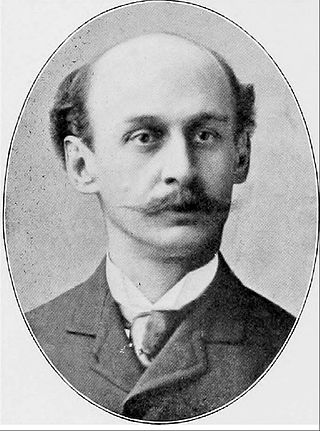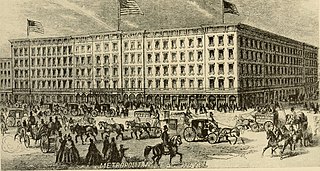
Henry Janeway Hardenbergh was an American architect, best known for his hotels and apartment buildings, and as a "master of a new building form — the skyscraper." He worked three times with Edward Clark, the wealthy owner of the Singer Sewing Machine Company and real estate developer: The Singer company's first tower in New York City, the Dakota Apartments, and its precursor, the Van Corlear. He is best known for building apartment dwellings and luxury hotels.

The Astor House was a luxury hotel in New York City. Located on the corner of Broadway and Vesey Street in what is now the Civic Center and Tribeca neighborhoods of Lower Manhattan, it opened in 1836 and soon became the best-known hotel in America. Part of it was demolished in 1913; the rest was demolished in 1926.

Niblo's Garden was a theater on Broadway and Crosby Street, near Prince Street, in SoHo, Manhattan, New York City. It was established in 1823 as "Columbia Garden" which in 1828 gained the name of the Sans Souci and was later the property of the coffeehouse proprietor and caterer William Niblo. The large theater that evolved in several stages, occupying more and more of the pleasure ground, was twice burned and rebuilt. On September 12, 1866, Niblo's saw the premiere of The Black Crook, considered to be the first piece of musical theater that conforms to the modern notion of a "book musical".

Clinton and Russell was a well-known architectural firm founded in 1894 in New York City, United States. The firm was responsible for several New York City buildings, including some in Lower Manhattan.

Maiden Lane is an east–west street in the Financial District of Lower Manhattan, New York City. Its eastern end is at South Street, near the South Street Seaport, and its western end is at Broadway near the World Trade Center site, where it becomes Cortlandt Street.

The Metropolitan Hotel in Manhattan, New York City, opened September 1, 1852, and was demolished in 1895. It was built at a time of a "hotel boom" in response to the opening of the New York Crystal Palace exhibition of 1853.

The Corbin Building is a historic office building at the northeast corner of John Street and Broadway in the Financial District of Manhattan in New York City. It was built in 1888–1889 as a speculative development and was designed by Francis H. Kimball in the Romanesque Revival style with French Gothic detailing. The building was named for Austin Corbin, a president of the Long Island Rail Road who also founded several banks.

The Grand Hotel is located at 1232–1238 Broadway at the corner of West 31st Street in the NoMad neighborhood of Manhattan, New York City.

Stephen Decatur Hatch (1839–1894) was a prominent late-19th century architect who was responsible for a number of historically or architecturally significant buildings in Manhattan, New York City and elsewhere. He primarily designed commercial buildings.

Daniel D. Badger was an American founder, working in New York City under the name Architectural Iron Works. With James Bogardus, he was one of the major forces in creating a cast-iron architecture in the United States. Christopher Gray of The New York Times remarks: "Most cast-iron buildings present problems of authorship – it is hard to tell if it was the founder or the architect who actually designed the facade."

John Butler Snook (1815–1901) was an American architect who practiced in New York City. He was responsible for the design of a number of notable cast-iron buildings, most of which are now in and around SoHo, Manhattan, as well as the original Grand Central Depot, which preceded the current Grand Central Terminal.

Amos Richards Eno was an American real estate investor and capitalist in New York City. He built the Fifth Avenue Hotel and many other developments on the streets of Broadway and Fifth Avenue, where he established a prominent family fortune of 20 to 40 million U.S dollars.

Joseph Fahys was one of the first U.S. watch case manufacturers. After emigrating from France, he went on to establish Joseph Fahys & Co., which at one time was the largest manufacturer of watch cases and one of the largest manufacturers of silverware in the United States. He was also the founder and first president of the Jewelers' Board of Trade, and the first president of the Watchcase Manufacturers' Association.

The Church of the Messiah at 728–30 Broadway, near Waverly Place in Greenwich Village, Manhattan, New York City, was dedicated in 1839 and operated as a church until 1864. In January 1865 it was sold to department store magnate Alexander Turney Stewart and converted into a theater, which subsequently operated under a series of names, including Globe Theatre, and ending with New Theatre Comique. It burned down in 1884.

The Pabst Hotel occupied the north side of 42nd Street in Manhattan, New York City, between 7th Avenue and Broadway, in Longacre Square, from 1899 to 1902. It was demolished to make room for the new headquarters of The New York Times, for which Longacre Square was renamed Times Square.

Lovejoy's Hotel was a New York City hotel from the 1830s through 1870. It was located at the corner of Park Row and Beekman Street in a six-story building in the Civic Center neighborhood of Manhattan. The Astor House hotel was opposite it.

14 Maiden Lane, or the Diamond Exchange, is an early example of a New York skyscraper in what is now the Financial District of Manhattan. Completed in 1894, it is still standing.
John Street is a street running west to east through the Financial District of Lower Manhattan in New York City. It is one of the oldest streets in the city. Long associated with maritime activity, the street ran along Burling Slip. The slip was filled in around 1840, and the street widened. Besides a wharf, warehouse, and chandlery, the city's first permanent theatre, and the first Methodist congregation in North America were located on John Street. It was also the site of a well-known pre-Revolutionary clash between the Sons of Liberty and British soldiers, pre-dating the Boston Massacre by six weeks.

The City Hotel (1794–1849) stood at 123 Broadway, occupying the whole block bounded by Cedar, Temple, and Thames Streets, in today's Financial District of Manhattan, New York City. It was the first functioning hotel in the United States. Until the early 1840s it was the city's principal site for prestigious social functions and concerts. Designed by John McComb Jr., it offered not only luxurious accommodations, but also such amenities as shops, a barroom, and a coffeehouse, as well as public dining and dancing. Its five stories and 137 rooms replaced the former home of Stephen Delancey, built around 1700, which had become an inn.

Gilsey Building is a former commercial building in Manhattan, completed in 1854 and demolished in May 1927. It was located in the south corner of Cortlandt Street, west side of Broadway, at 169-171 Broadway, situated diagonally across from the Howard Hotel. Its proprietor, Peter Gilsey, has acquired a fortune in the cigar business, and also owned Gilsey House. The material was iron, and the color was white. The building's location made the numerous law and business offices among the most desirable in the city. It was a real estate holdout, forcing construction of the City Investing Building to wrap around it. The Gilsey Building was the first iron frame building erected in New York City.




















